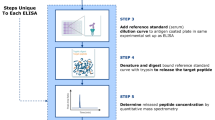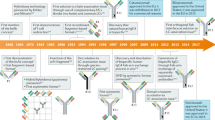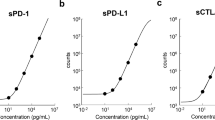Abstract
To design a sensitive and reproducible immunoassay for interleukin 2 (IL–2), two IL–2 reactive monoclonal antibodies (DMS–1 and DMS–5) were characterized extensively. The unique IL–2 binding characteristics of DMS 1 and DMS 5 were exploited to construct an IL–2 immunoassay that is sensitive to 10 pM murine and human IL–2 (150 pg/ml), amenable to both radioisotopic and enzymatic detection, and readily available to other laboratories.
This is a preview of subscription content, access via your institution
Access options
Subscribe to this journal
Receive 12 print issues and online access
$209.00 per year
only $17.42 per issue
Buy this article
- Purchase on Springer Link
- Instant access to full article PDF
Prices may be subject to local taxes which are calculated during checkout
Similar content being viewed by others
References
Morgan, D.A., Ruscetti, F.W., and Gallo, R. 1976. Selective in vitro growth of T lymphocytes from normal human bone marrows. Science 193:1007–1008.
Gillis, S., and Smith, K.A. 1977. Long-term culture of cytotoxic T lymphocytes. Nature 268:154–156.
Smith, K.A. 1984. Interleukin 2. Ann. Rev. Immunol. 2:319–333.
Gillis, S., Ferm, M.M., Ou, W., and Smith, K.A. 1978. T-cell growth factor: parameters of production and a quantitative microassay for activity. J. Immunol. 120:2027–2032.
Smith, K.A., Baker, P.E., Gillis, S., and Ruscetti, F.W. 1980. Functional and molecular characteristics of T cell growth factor. Mol. Immunol. 17:579–589.
Robb, R.J., and Smith, K.A. 1981. Heterogeneity of human T cell growth factor due to glycosylation. Mol. Immunol. 81:1087–1094.
Taniguchi, T., Matsui, H., Fujita, T., Takaoka, C., Kashima, N., Yoshimoto, R., and Hamuro, J. 1983. Structure and expression of a cloned cDNA for human interleukin-2. Nature 302:305–310.
Smith, K.A., Favata, M.F., and Oroszlan, S. 1983. Production and characterization of monoclonal antibodies to human interleukin 2: Strategy and tactics. J. Immunol. 131:1808–1815.
Budd, R., and Smith, K.A. 1986. Interleukin 2 monoclonal antibody affinity adsorption: The critical role of binding kinetics for optimal immunoadsorption. Submitted.
Trivers, G.E., Harris, C.C. ; Rougeot, C., and Dray, F. 1983. Development and use of ultrasensitive enzyme immunoassays. Methods Enzymol. 103:409–434.
Robb, R.J., Munck, A., and Smith, K.A. 1981. T cell growth factor receptors: quantitation, specificity and biological relevance. J. Exp. Med. 154:1455–1474.
Kendall, C., Ionescu-Matiu, I., and Dreesman, G.R. 1983. Utilization of the biotin/avidin system to amplify the sensitivity of the enzyme-linked immunosorbent assay (ELISA). J. Immunol. Methods 56:329–339.
Staehelin, T., Stahli, C., Hobbs, D.S., and Pestka, S. 1981. A rapid quantitative assay of high sensitivity for human leukocyte interferon with monoclonal antibodies. Methods Enzymol. 79:589–595.
Chang, T.W., McKinney, S., Liu, V., Kung, P.C., Vilcek, J., and Le, J. 1984. Use of monoclonal antibodies as sensitive and specific probes for biologically active human γ-interferon. Proc. Natl. Acad. Sci. USA. 81:5219–5222.
Gehman, L.O., and Robb, R.J. 1984. An ELISA-based assay for quantitation of human interleukin 2. J. Immunol. Meth. 74:39–47.
Rosenberg, S.A., Lotze, M.T., Muul, L.M., Leitman, S., Chang, A.E., Ettinghausen, S.E., Matory, Y.L., Skibber, J.M., Shiloni, E., Vetto, J.T., Seipp, C.A., Simpson, C., and Reichert, C.M. 1985. Observations on the systematic administration of autologous lymphokine-activated killer cells and recombinant interleukin 2 to patients with metastatic cancer. New Eng. J. Med. 313:1485–1492.
Gillis, S. and Watson, J. 1980. Biochemical and biological characterization of lymphocyte regulatory molecules. V. Identification of interleukin 2 producing human leukemia T cell line. J. Exp. Med. 152:1709–1719.
Farrar, J.J., Fuller-Farrar, J., Simon, P.L., Hilfiker, M.L., Stadler, B.M., and Farrar, W.L. 1980. Thymoma production of T cell growth factor (interleukin 2). J. Immunol. 125:2555–2558.
Baker, P.E., Gillis, S., and Smith, K.A. 1979. Monoclonal cytolytic T cell lines. J. Exp. Med. 149:273–278.
Guesdon, J.-L., Ternynck, T., and Avrameas, S. 1979. The use of avidin-biotin interaction in immunoenzymatic techniques. J. Histochem. 27:1131–1134.
Author information
Authors and Affiliations
Rights and permissions
About this article
Cite this article
Budd, R., Smith, K. Interleukin 2 Immunoassay Using Monoclonal Antibodies. Nat Biotechnol 4, 983–986 (1986). https://doi.org/10.1038/nbt1186-983
Received:
Accepted:
Issue Date:
DOI: https://doi.org/10.1038/nbt1186-983
This article is cited by
-
A Novel Approach to Bioassays
Bio/Technology (1988)



